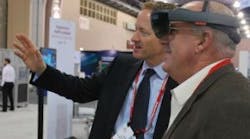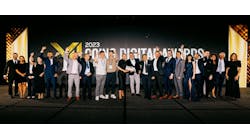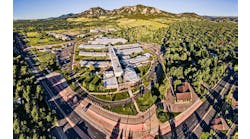John Pritchard of Rockwell Automation guided our intrepid author through the company’s Innovations booth at Automation Fair, where a concept production line was used to bring applications of current cutting-edge and future automation technology to life.
The Innovations booth at Automation Fair is where dreams meet reality, where concept meets creation, and this year where digital meets physical. The centerpiece of futuristic pavilion on display this week in Philadelphia is a keen demonstration of how digital and physical components can blend together seamlessly into a production facility designed and built quickly, inexpensively and optimally.“There are many benefits, but upfront innovation and downstream reduced commissioning time are the obvious ones,” said John Pritchard, strategic business development manager, Rockwell Automation. “It’s a showcase of how technologies can come together to improve physical operations in the digital world.”
In this scenario, a manufacturer can have an idea and get to test it faster and without the typical costs, said Pritchard. “It allows design iterations,” he explained. “You can try five or six ideas out in a morning. You get a lot of learning done early and less expensively than doing it in the physical world, which makes it more cost-effective. The speed and cost of innovation are reduced.”
The future, here and now
The production-line demonstration features a variety of forward-looking technologies from Rockwell Automation, including the MagneMotion cart technology. “We’ll continue to see more flexible, agile technologies such as MagneMotion and iTrak,” said Pritchard.
PTC Vuforia Augmented Reality software is running on Microsoft HoloLens to allow voice-controlled quality check in a semi-virtual environment. “The quality-check station lets you use augmented reality to receive the work instruction and carry out the quality check using voice commands,” explained Pritchard.
Area scanners using infrared light are in place for safeguarding. “Augmented reality is also being showcased as a way to see the safety zones around the line. Vuforia is able to show you where the safety areas are. It’s able to understand the shape of the machine,” he explained.
Emulate3D software runs a digital factory on the large-screen display, and all is controlled with ControlLogix control systems.
Finally, the Odos Imaging StarForm Swift 3D camera, a late 2017 Rockwell Automation acquisition, is used to sense product presence and height. “The Odos Imaging 3D sensor is doing completeness checking,” explained Pritchard. “We see this as an exciting new technology with multiple applications in consumer-packaged-goods manufacturing.”
Cama, an Italian builder of packaging equipment, has in fact started implementing this scenario in real life. “They’re using these technologies for real,” explained Pritchard.
Project efficiency
One of the biggest benefits of the digitalization from a project perspective lies in the ability to test control code in a virtual environment. “Because you’ve written real control code—and used it to automate virtual machines—when you come to site to commission it, you’re not debugging code on site,” explained Pritchard. “You’ve already written code and debugged it. You’re plugging it in and switching it on.”
A typical startup time of six to eight weeks can be streamlined and reduced to two weeks with this approach. “That’s expensive and inconvenient time,” said Pritchard. “And it’s high-pressure time because everyone wants to get the plant up and running.”
The Rockwell Automation team also is getting input for future developments and hosted more than 50 feedback sessions with customers over the course of Automation Fair.
“Building on the theme of physical and digital, we are also showing how our engineers who make the ControlLogix processors have deployed AI—deep neural network methodologies—to analyze and improve the yield output of the surface-mount production line,” said Pritchard. “They were able to analyze early in the production process the likelihood that a product would pass final test. Overnight, they ended up with a 90% success of predicting that.”
Two other significant demonstrations showcased in the Innovations pavilion include voice control and facial recognition.
“We also showed a couple examples of different ways to interface with your automation,” said Pritchard. “The voice-controlled tower light uses an LED approach, so it can be any color and can be solid, flashing or rotating. For each slice, you have to configure it. If you have 20 of them to configure, you could do them all at the same time.
“There’s also the new facial recognition feature for ThinManager software,” he said. “Over time when you sign in, it learns what you look like. It will automatically recognize you and enter your credentials, saving time and increasing security.”
The editors of Control are on-site at Automation Fair 2018 to bring you breaking news, innovations and insights from the event. Once the event is over, they will put together a report featuring the top news. Pre-order your copy today.





